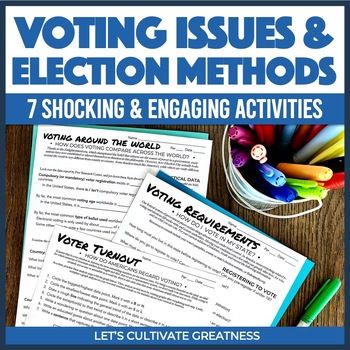Election Day Voting Activities on Voter Rights & Behavior - Civics Activities
- PDF
- Google Apps™

What educators are saying
Description
Dive into voting rights, voter turnout, voter registration, and voting methods in this 7-activity Election Day prep kit.
This kit works great as once-a-week stand-alone lessons or a two-week mini-unit leading to Election Day.
Or save for super easy sub plans any time in your Civics or Government class.
This resource comes in both printable PDF and paperless Google files.
Get this and a bunch more activities in the complete 3-5 week Voting & Elections PBL Unit and make engaged citizens out of your students.
Greatness is honoring and desiring to be a contributing member of one’s representative democracy.
Nothing is more real or urgent than preparing your students to be informed voters, even when they aren't 18 and if it's an "off" year election.
Multiple studies have proven that when teenagers participate in voting, even in a mock election, they are more likely to vote as adults; additionally, their parents have a higher voter turnout in that year's election. Be the cause of this highest form of civic engagement!
This year, let’s leave the way-out-of-date textbook behind and take students straight to the front-page news of today with primary sources, news articles and editorials, data graphs, and official campaign websites to answer the question, "What does it mean to vote in America?"
Included in this Voting Activity Kit:
Overview
- At-a-glance Overview sheet and detailed daily lesson plans for you
- Conceptual note-taking form for students to build their understanding of voting
Student Activities:
- Voting Rights Timeline match-up: work in teams to determine when groups of Americans received the right to vote
- Voting Rights podcast: jot down the fascinating facts about the history of voting rights in America while listening to an engaging Civics 101 podcast
- Voting Requirements: research the rules and deadlines to register to vote and cast a ballot in your state
- Voting Methods Pro/Con: research ways voting is done in America, from mail-in ballots to photo ID requirements to automatic registration
- Voter Turnout graph gallery walk: explore various data graphs on the complex issue of low voter turnout in U.S. elections
- How We Vote podcast: jot down the fascinating facts about Election Day logistics over time in America while listening to an engaging Civics 101 podcast
- Voting Around the World: examine and compare election day photos and voting laws from other nations
What Other Teachers Are Saying About This Kit
⭐️⭐️⭐️⭐️⭐️ This was an engaging way to introduce voting rights and concepts to my government students. Several were surprised that voting rights weren't spelled out in the Constitution, despite us having gone over the Constitution earlier. – Cody
⭐️⭐️⭐️⭐️⭐️ Easy-to-use supplemental activities for my voting and elections unit. Thank you! – Elizabeth
⭐️⭐️⭐️⭐️⭐️ This resource is detailed, organized, and thorough. It was exactly what I was looking for in my high school special education classroom. Thank you for all your hard work that went into making this product! – Fellow TPT Seller
⭐️⭐️⭐️⭐️⭐️ Great resource with a lot of activities that sparked meaningful discussions in class. – Tasha
Want the full unit?
Voting & Elections Unit make informed and engaged voters out of your students in the 3-5 week unit!
Want more American Government / Civics units?
Foundations of American Democracy examine the principles and values on which our government is founded
Three Branches Unit contrast how the federal government works in theory and in practice
Constitutional Rights Unit determine exactly how our rights translates into daily American life
Constitutional Issues Research Paper Project end with a highly-scaffolded, college-ready research paper
Want the whole semester AND save big?
Civics & American Government course bundle teach this inquiry-driven and project-based semester course with confidence!
This listing is for one license for regular, non-commercial classroom use by a single teacher only. Commercial use like online teaching (ex. Outschool) or sharing with other teachers (ex. shared drive, in a Facebook group, in a professional development training) is strictly prohibited.
By purchasing a license to this resource, you have access to all future updates at no cost, available under “My Purchases." Multiple and transferable licenses are available for purchase. PDF files are uneditable, other files have editing abilities, unless otherwise stated. All files are protected under federal copyright laws.





